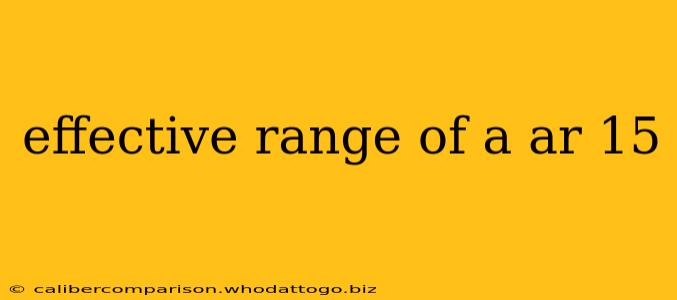The effective range of an AR-15 is a frequently asked question, and the answer isn't a simple number. It depends heavily on several factors, including the specific ammunition used, the skill of the shooter, and the target's size. We'll break down the different aspects to give you a comprehensive understanding.
Understanding "Effective Range"
Before we delve into specifics, let's clarify what "effective range" means. It's not simply the maximum distance a bullet can travel (which can be hundreds of yards or even over a mile depending on the ammunition and barrel length). Effective range refers to the distance at which a shooter can consistently and reliably hit a target of a given size with sufficient accuracy to achieve the desired effect. This effect is usually incapacitation or neutralization of the target.
Factors Affecting AR-15 Effective Range
Several key factors significantly impact the effective range of an AR-15:
1. Ammunition:
- Bullet Type: Heavier bullets generally retain velocity and energy better over longer distances, increasing effective range. Different bullet designs (e.g., full metal jacket, hollow point) also affect trajectory and terminal performance.
- Grain Weight: Higher grain weight bullets tend to be more accurate at longer ranges due to their better ballistic coefficient.
- Velocity: Higher muzzle velocity translates to a flatter trajectory and less bullet drop at longer ranges.
2. Barrel Length:
- A longer barrel generally provides higher velocity and greater accuracy, extending the effective range. Shorter barrels reduce velocity and can impact accuracy, especially at longer distances.
3. Optics:
- The quality and magnification of the optic significantly influence the shooter's ability to accurately engage targets at longer ranges. A red dot sight is suitable for close-to-medium range, while a magnified optic is necessary for longer-range shooting.
4. Shooter Skill:
- This is arguably the most critical factor. A skilled marksman can achieve higher accuracy at greater distances than a less experienced shooter, regardless of the rifle's capabilities. Proper training, practice, and understanding of ballistics are crucial.
Defining Effective Ranges for Different Scenarios:
While a single number is impossible, we can offer estimates based on common scenarios:
-
Point Target (e.g., Human-sized): For a skilled shooter with suitable optics and ammunition, an effective range for accurate hits on a human-sized target could extend to 300-500 yards. However, maintaining consistent accuracy beyond this range becomes increasingly difficult for even the most experienced shooters.
-
Area Target (e.g., Larger Vehicle): Engaging a larger target allows for a degree of error. Effective range for area targets could be extended somewhat beyond the point target ranges mentioned above.
-
Self-Defense: Most self-defense scenarios occur at considerably shorter ranges, often within a few yards. The effective range for close-quarters self-defense is far less critical than accuracy and rapid target acquisition.
Conclusion:
The effective range of an AR-15 is not a fixed value. It's a dynamic range influenced by ammunition selection, barrel length, optics, and, most importantly, the shooter's skill and training. While it is possible to hit targets at greater distances, achieving consistent accuracy and reliable incapacitation requires careful consideration of all these factors. Responsible gun ownership includes understanding these limitations and practicing safe firearm handling at all times.

